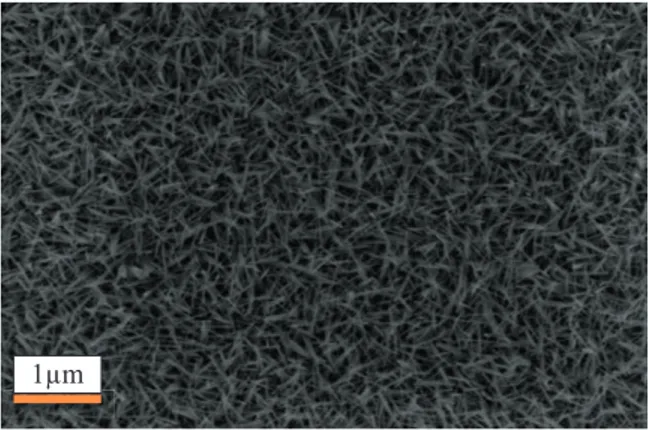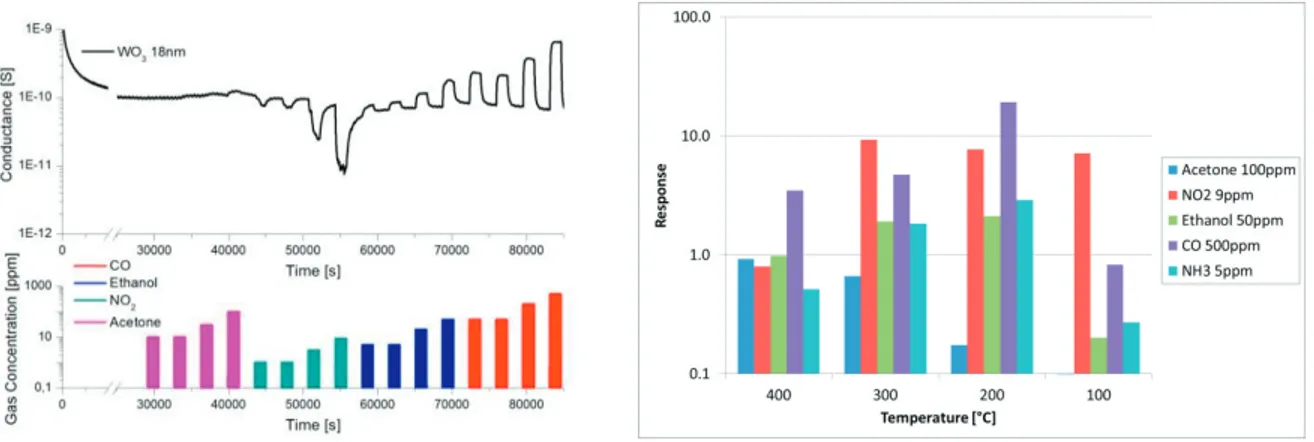Procedia Engineering 87 ( 2014 ) 696 – 699
1877-7058 © 2014 The Authors. Published by Elsevier Ltd. This is an open access article under the CC BY-NC-ND license (http://creativecommons.org/licenses/by-nc-nd/3.0/).
Peer-review under responsibility of the scientific committee of Eurosensors 2014 doi: 10.1016/j.proeng.2014.11.632
ScienceDirect
Available online at www.sciencedirect.com
EUROSENSORS 2014, the XXVIII edition of the conference series
Tungsten oxide nanowires chemical sensors
Dario Zappa*, Angela Bertuna, Elisabetta Comini, Marco Molinari, Nicola Poli, Giorgio
Sberveglieri
SENSOR Laboratory, University of Brescia and CNR-INO, Via Valotti 9, 25133 Brescia, Ital
Abstract
Tungsten oxide nanowires have been synthetized by a simple thermal oxidation route in an oxygen atmosphere, at low vacuum pressure. The morphology of the nanostructures was investigated by scanning electron microscope (SEM).
Chemical sensors were fabricated using tungsten oxide nanowires as active layer, directly deposited on the transducer. Gas sensing performances were evaluated towards some target chemical species (CO, NO2, NH3, Acetone, Ethanol). Firstly, a temperature screening was performed in presence of a fixed gas concentration, to determine the optimal working temperature of the sensors. Then, calibration curves for some chemical species were estimated. The influence of relative humidity was taken into account. Fabricated devices seem very promising for the detection of ammonia and carbon monoxide.
© 2014 The Authors. Published by Elsevier Ltd.
Peer-review under responsibility of the scientific committee of Eurosensors 2014. Keywords: Tungsten Oxide; Metal Oxide Nanowires; Chemical Sensors
1. Introduction
Metal oxide nanowires are well-known as candidate for next generation of low-cost chemical sensors. Scientific research is looking forward new materials that exhibit excellent performances together with high selectivity and stability over time.
Tungsten oxide is a n-type promising semiconductor material that is under investigation by quite long time, especially in form of thin film [1]. Nanostructured tungsten oxide could enhance the overall performances of the devices compared to traditional thin film technology [2].
* Corresponding author. Tel.: +390303715767;
E-mail address: [email protected]
© 2014 The Authors. Published by Elsevier Ltd. This is an open access article under the CC BY-NC-ND license (http://creativecommons.org/licenses/by-nc-nd/3.0/).
697 Dario Zappa et al. / Procedia Engineering 87 ( 2014 ) 696 – 699
Thermal oxidation is a technique that was successfully used to synthetize metal-oxide materials [3]. In the present work it was slightly adapted to be used in low vacuum environment, in order to reduce the oxygen partial pressure in the atmosphere.
2. Experimental
Tungsten oxide nanowires were synthetized on both silicon and alumina substrates: silicon substrates (10x10 mm2) were used for morphological investigations; alumina (2x2 mm2) was used for the fabrication of sensing devices. A 18nm thin layer of metallic tungsten was deposited on target substrates by RF magnetron sputtering at 300°C, using a 100W Argon plasma (pressure was 5.5x10-3 mbar). The film was then oxidized in a tubular furnace at 550°C for one hour at 1 mbar pressure.
Conductometric mat-based devices were prepared depositing interdigitated platinum contacts on the front side of samples, while a platinum heater was deposited with the same technique, to thermally activate metal oxide interaction with the surrounding atmosphere. The substrate was bonded on 4-pins TO package using gold wires. Samples undergone a thermal stabilization period prior to electrical characterization.
A custom climatic chamber was used to evaluate the performance of fabricated nanostructures (Fig. 2). Sensors were exposed to various concentration of both oxidizing and reducing chemical species. Relative humidity was set at 50% @ 20°C during temperature screening, to find out the optimal working temperature of the devices. Afterwards calibration curves were estimated for carbon monoxide, nitrogen dioxide and ammonia. The influence of humidity was also taken into account. We changed the humidity level form 0% to 75% and detected the response ratio compared to the standard 50% level. The response of the device was evaluated by the variation of the electrical conductance compared to the base conductance (ΔG/G).
A FE-SEM LEO 1525 microscope was used to evaluate the morphology of the tungsten oxide nanowires. The beam was operated at 5kV.
3. Results
In Fig. 1 is reported the morphology of the fabricated nanostructures. We obtained a dense mat of tungsten oxide nanowires uniformly distributed on the substrates. The average diameter of the nanowires was between 20-40nm, while the length was less than 1 μm.
Dynamic response was recorded by the chamber electronics, measuring the variation of the electrical conductance in presence of fixed concentrations of target gases. Fig. 2 (Left) exhibits the response of WO3 nanowires at 200°C towards some chemical species like carbon monoxide, ethanol, acetone and nitrogen dioxide. The behavior of the material is as expected from n-type semiconductors. We observed an increase of the conductance in presence of
Fig. 1: SEM picture of tungsten oxide nanowires at 50k magnification level.
698 Dario Zappa et al. / Procedia Engineering 87 ( 2014 ) 696 – 699
reducing gases like carbon monoxide and ethanol, while we obtained a decrease in presence of an oxidizing gas like nitrogen dioxide. The temperature of 200°C resulted the optimal one for the detection of carbon monoxide, ammonia and nitrogen dioxide (Fig. 2, Right). For acetone instead, the optimal working temperature was 400°C.
The influence of the relative humidity on sensor response was also taken into account (Fig. 3). Device responses reported in Fig. 3 have been normalized respect to the RH=50% values, our standard reference value for evaluating the sensing performance of the material. Nitrogen dioxide sensing is strongly affected by the amount of water in the atmosphere, especially in the range of 25-75% of relative humidity @ 20°C. Carbon monoxide instead is more or less not sensitive to humidity variations. Ammonia detection is quite stable in the 25-75% relative humidity range.
4. Conclusions
We successfully fabricated tungsten oxide conductometric sensing devices starting from a metal film directly deposited on the final alumina transducer. SEM investigations confirmed the nanowire-like morphology of the synthetized nanostructures. An electrical characterization have been performed on the devices in order to evaluate their sensing performances. They proved to be quite sensitive to different concentration of ammonia, carbon monoxide
Fig. 2: (Left) Dynamic response of sensing devices towards some oxidizing and reducing gas chemical compound, measured at 200°C with a relative humidity of 50% @ 20°C. (Right) Temperature dependence of the response of 18nm WO3 nanostructures, measured with a relative humidity of 50% @ 20°C.
Fig. 3: Influence of humidity on 18nm device response towards nitrogen dioxide, carbon monoxide and ammonia. On the y-axis the ratio between the response at the target value of relative humidity respect the reference value of RH=50% @ 20°C.
699 Dario Zappa et al. / Procedia Engineering 87 ( 2014 ) 696 – 699
and nitrogen dioxide, even at a relatively low temperature (200°C). Moreover, fabricated devices exhibit a good stability of the response in presence of humidity variation, especially towards carbon monoxide and ammonia.
The presented technique is ideal for the fabrication of low-cost tungsten-oxide nanowire sensors with a high yield, a key feature for industrial mass-production.
Acknowledgements
The work has been supported by the Italian MIUR through the FIRB Project RBAP115AYN “Oxides at the nanoscale: multifunctionality and applications. This work was partially supported by the European Community’s 7th Framework Programme, under the grant agreement n° 611887 “MSP: Multi Sensor Platform for Smart Building Management” and ORAMA project FP-NMP-2009-LARGE-3 NMP-2009-2.2-1, Grant Agreement 246334: “Oxide Materials Towards a Matured Post-silicon Electronics Era”
References
[1] Wang, X.S., Miura, N. and Yamazoe, N., Sens. Actuator B-Chem. 2000, 66(1-3), 74
[2] Meng, D., Shaalan, N.M., Yamazaki, T. and Kikuta, T., Sens. Actuator B-Chem. 2012, 169, 113 [3] Zappa, D., Comini, E. and Sberveglieri, G., Nanotechnology. 2013, 24(44)

